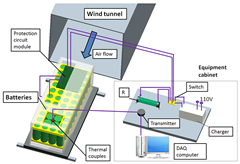Intelligent Power Systems
Annual PlanPowertrain Thermal Management - Combined Experimental and Computational Study of Battery Cooling in Hybrid Electric Vehicles
Project Summary
Principal Investigator
- Lin Ma, Virginia Tech
Faculty
- John Wagner, Clemson University
Student
- Andrew Wickersham, Frank He, Xuesong Li, Virginia Tech
Government
- Peter Schihl, Yi Ding, U.S. Army GVSC
Industry
- Kim Yeow, AVL Powertrain Engineering
- Hoseinali Borhan, Advanced Hybrid Cummins Inc.
Project duration 2011-2014.

The batteries used in hybrid electric vehicles (HEVs) pose significant challenges for thermal management. First, HEVs typically require rapidly charging and discharging the batteries. Such requirement can lead to highly dynamic thermal load, resulting in relatively large and irregular temperature fluctuations. Second, batteries have a narrow temperature range for efficient and safe operation. For example, lithium–titanate batteries have a maximum operation temperature of 55 deg-C and lead acid batteries have a desired operating range of 25 – 45 deg-C, while the ambience air temperature could vary from -20 to 50 deg-C. Third, significant non-uniform cooling across batteries cells have been identified, resulting in hot-spots which act as weak link in battery systems. These challenges call for innovative battery cooling techniques that can accommodate the waste heat from large charge and discharge currents without compromising battery efficiency and life.
Prior ARC research has identified the following needs:
- Controlled and well-documented experimental data are needed to validate and develop thermal management models, especially data under relevant driving conditions. These models typically involve multiple empirical parameters, which have non-negligible effects on the predictions made by these models.
- Significant temperature variation exists among cells and across different parts of the same cell. Such variation (i.e., the existence of hot spots in pack) has a detrimental effect on batteries. Existing experimental and numerical methods are inadequate to resolve such non-uniformities.
This project conducts combined experimental and computational efforts to address these research needs. The ultimate goal is to deliver validated models based on first-principles for the optimized design of battery cooling subsystems, in terms of the cooling effectiveness and reliability, pressure drop, power consumption, and size.
This projects actively collaborates ARC researchers in the areas of battery thermal modeling, thermal issues of e-motors, integration of battery cooling sub-system in the overall powertrain control and optimization framework.
Publications:
- Cai, W., Kranendonk, L., Lee, T., and Ma, L., “Characterization of Composite Nanoparticles using an Improved Light Scattering Program for Coated Spheres”, Computer Physics Communications, vol. 181, pp. 978-984, May 2010. doi:10.1016/j.cpc.2010.01.010
- Finn, J.; Ewing, D.J.; Lin Ma; Wagner, J.; , “Thermal protection of vehicle payloads using phase change materials and liquid cooling,” American Control Conference (ACC), pp.1204-1210, June 30 2010-July 2 2010. (link - IEEE)
- Finn, J., Ewing, D.J., Ma., L., and Wagner, J., “Nanofluid Augmented Coolant Rail Thermoelectric Cooling of Electronic Systems – Modeling and Analysis”, proceedings of the 2011 American Controls Conference, San Francisco, CA, June 2011. (link - IEEE)
- Li, F.; Yu, X.; Gu, H.; Li, Z.; Zhao, Y.; Ma, L.; Chen, L.; Chang, X.; Simultaneous Measurements of Multiple Flow Parameters for Scramjet Characterization Using Tunable Diode-Laser Sensors, Applied Optics, v50 Iss36, p6697-6707, Dec 2011.
doi:10.1364/AO.50.006697 - X. Li, F. He, L. Ma, “Thermal management of cylindrical batteries investigated using wind tunnel testing and computational fluid dynamics simulation”, Journal of Power Sources, Volume 238, Pages 395–402, September 2013.
- F. He, X. Li, L. Ma, “Combined experimental and numerical study of thermal management of battery module consisting of multiple Li-ion cells”, International Journal of Heat and Mass Transfer, Vol. 72, pp.622-629, 2014.

